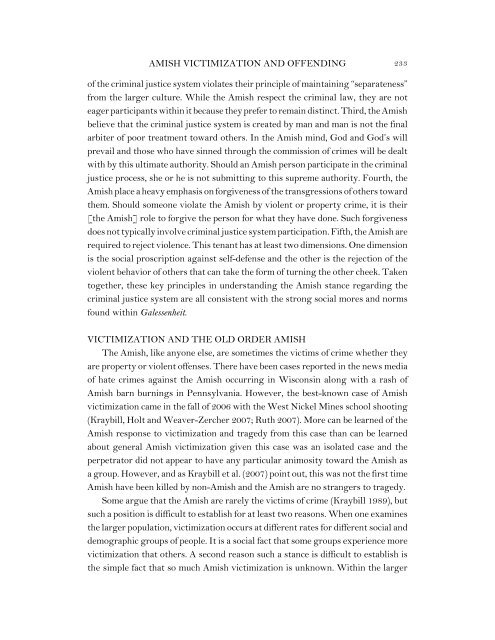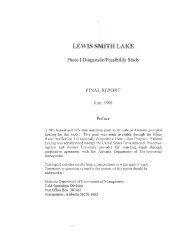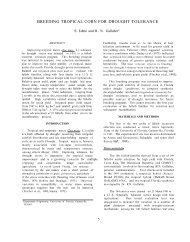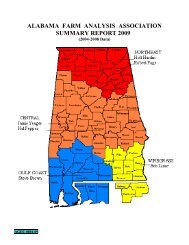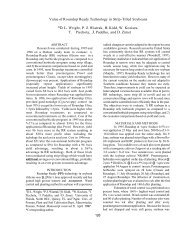AMISH VICTIMIZATION AND OFFENDING: A RURAL ...
AMISH VICTIMIZATION AND OFFENDING: A RURAL ...
AMISH VICTIMIZATION AND OFFENDING: A RURAL ...
Create successful ePaper yourself
Turn your PDF publications into a flip-book with our unique Google optimized e-Paper software.
<strong>AMISH</strong> <strong>VICTIMIZATION</strong> <strong>AND</strong> <strong>OFFENDING</strong> 233<br />
of the criminal justice system violates their principle of maintaining “separateness”<br />
from the larger culture. While the Amish respect the criminal law, they are not<br />
eager participants within it because they prefer to remain distinct. Third, the Amish<br />
believe that the criminal justice system is created by man and man is not the final<br />
arbiter of poor treatment toward others. In the Amish mind, God and God’s will<br />
prevail and those who have sinned through the commission of crimes will be dealt<br />
with by this ultimate authority. Should an Amish person participate in the criminal<br />
justice process, she or he is not submitting to this supreme authority. Fourth, the<br />
Amish place a heavy emphasis on forgiveness of the transgressions of others toward<br />
them. Should someone violate the Amish by violent or property crime, it is their<br />
[the Amish] role to forgive the person for what they have done. Such forgiveness<br />
does not typically involve criminal justice system participation. Fifth, the Amish are<br />
required to reject violence. This tenant has at least two dimensions. One dimension<br />
is the social proscription against self-defense and the other is the rejection of the<br />
violent behavior of others that can take the form of turning the other cheek. Taken<br />
together, these key principles in understanding the Amish stance regarding the<br />
criminal justice system are all consistent with the strong social mores and norms<br />
found within Galessenheit.<br />
<strong>VICTIMIZATION</strong> <strong>AND</strong> THE OLD ORDER <strong>AMISH</strong><br />
The Amish, like anyone else, are sometimes the victims of crime whether they<br />
are property or violent offenses. There have been cases reported in the news media<br />
of hate crimes against the Amish occurring in Wisconsin along with a rash of<br />
Amish barn burnings in Pennsylvania. However, the best-known case of Amish<br />
victimization came in the fall of 2006 with the West Nickel Mines school shooting<br />
(Kraybill, Holt and Weaver-Zercher 2007; Ruth 2007). More can be learned of the<br />
Amish response to victimization and tragedy from this case than can be learned<br />
about general Amish victimization given this case was an isolated case and the<br />
perpetrator did not appear to have any particular animosity toward the Amish as<br />
a group. However, and as Kraybill et al. (2007) point out, this was not the first time<br />
Amish have been killed by non-Amish and the Amish are no strangers to tragedy.<br />
Some argue that the Amish are rarely the victims of crime (Kraybill 1989), but<br />
such a position is difficult to establish for at least two reasons. When one examines<br />
the larger population, victimization occurs at different rates for different social and<br />
demographic groups of people. It is a social fact that some groups experience more<br />
victimization that others. A second reason such a stance is difficult to establish is<br />
the simple fact that so much Amish victimization is unknown. Within the larger


